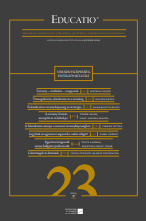A vidék mint földrajzi periféria és az oktatás mint kitörési pont
Rural Territories as Peripheries of Hungary
Author(s): István Süli-Zakar, Gábor LenkeySubject(s): Education, Geography, Regional studies, Recent History (1900 till today), Rural and urban sociology, Human Resources in Economy
Published by: Akadémiai Kiadó
Keywords: Disadvantaged situation; geographical periphery; rural development; human resource development;
Summary/Abstract: The lessening of the amount of the rural territories started with the industrial revolution, in the 19th century, in Hungary. The reason was that the industrial revolution used Hungarian rural territories as its main (human) resources. As industrialisation went on, more and more people ‘escaped’ from agriculture to industry (of various kinds), thereby moving from rural territories to urban regions. The process of industrialisation slowed down after the First World War in the country, however – which caused severe social-political problems in the rural territories: farmers could no longer live on their own properties as they had been lost in earlier decades and, at the same time, industry was unable to make use of as many human resources as beforehand. After the Second World War and the communist take-over, industrialisation started up again, though in a forced, dictatorial way (e.g. with development of heavy industry after the Soviet model together with the nationalisation of both industrial as well as agricultural ventures). The direction of the ‘planned economy’ became less crude after the 1956 revolution, i.e. a special, rather unique ‘mixed economy” emerged within Comecon –which suddenly disappeared after the political turnaround of 1989/90. The last two decades has moved the country a long way down the pauperisation ladder; and as the only means of escape from such pauperisation, the authors suggests a) a newly formed regional policy, and b) a well-organised basic education which could even reach down to three-year olds.
Journal: Educatio
- Issue Year: 23/2014
- Issue No: 3
- Page Range: 371-383
- Page Count: 13
- Language: Hungarian

